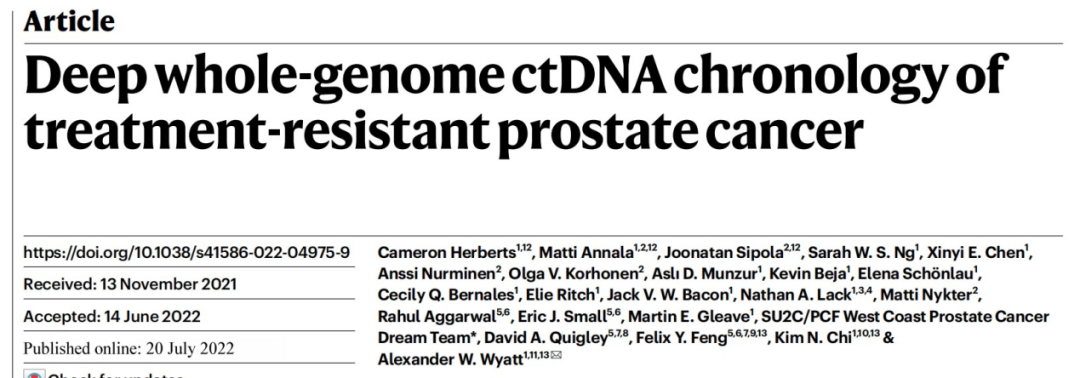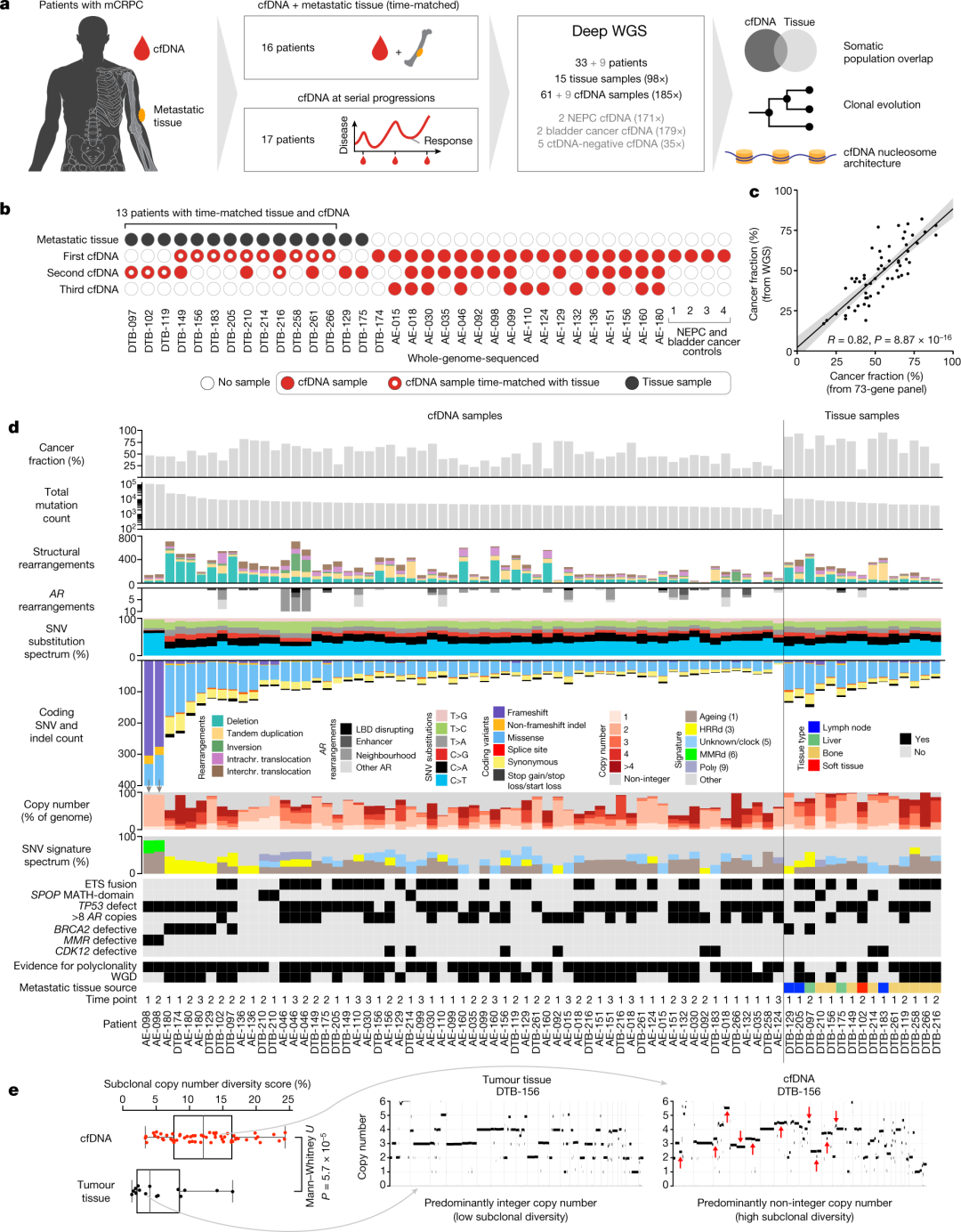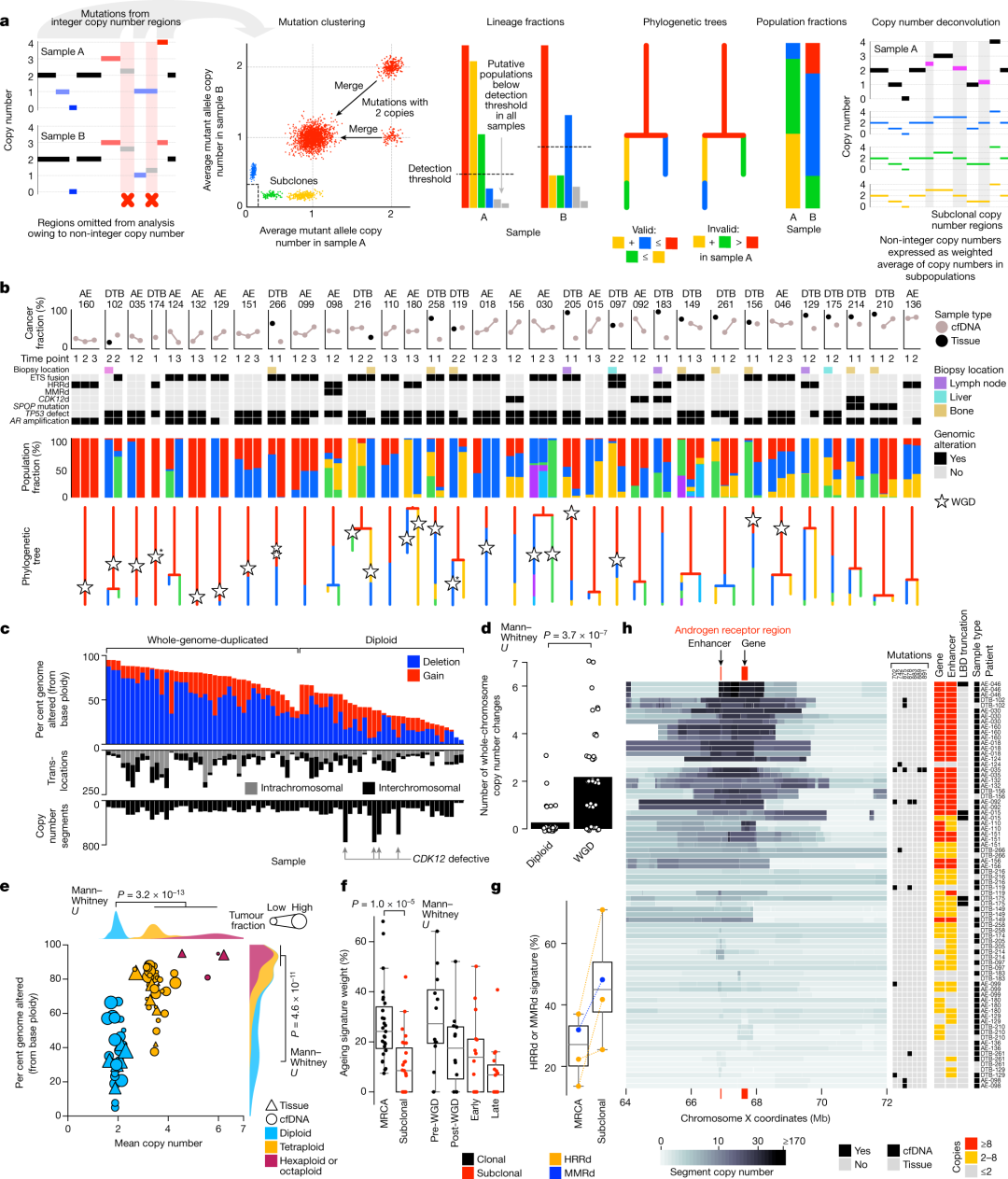Destroyer resistance front genome CTDNA sequencing diagram
Author:Bioart biological art Time:2022.08.07

Written article | Chunxiao
#Tumor#
The circulatory tumor DNA (CIRCULATING TUMOR DNA, CTDNA) in the blood may bring a lot of meaningful information to doctors in early diagnosis, selection of treatment, and relapse monitoring. , Integration of transcription and apparent genome. This information is urgent to excavate the potential of tumor occurrence, metastases and tumor resistance mechanisms.
Previous research mainly adopted a whole genome sequencing, or using fresh tissues, or tracking the dynamics of a mutation, lack of deep clinical-genomic resolution analysis, between the time between CTDNA and tumor metastases, and what is the relationship between dynamic changes. It is not clear. Therefore, in -depth whole genome sequencing analysis of the clinical sample CTDNA of patients may bring a lot of useful information to clinicians.
On July 20, 2022, the Alexander W. Wyatt research team at the Department of Urology of Columbia University of Canada published a research paper entitled by the Deep WHLE-Genome CTDNA ChristNA Christ-Resistance Cancer in the Nature-Genome CTDNA Chronology. For the first time, the author conducted in -depth whole genome sequences on CTDNA and metastatic biopsy for prostate cancer. It is found that the CTDNA in the patient's blood can complete the evolutionary analysis of prostate cancer, cloning dynamic formation, genome and transcription in depth analysis, and breakthroughs have broken through. In the past, only the restrictions of fresh tissue can be used to open a new model of liquid biopsy for clinical genetic research, which brings unlimited possibilities for clinical genetic new discoveries.

The author conducted in -depth whole genome for 33 cases of metastases to resist prostate cancer (MCRPC) patients, 15 prostate cancer patients, 2 cases of metastatic nerve endocrine prostate cancer samples, 2 cases of metastatic bladder cancer patients, and 2 cases of metastatic bladder cancer patients. In order, there are 5 other CTDNAs that are not detected to analyze the comparison (Figure 1). A total of 68,7293 individual cell mutations and 16,200 structural rearrangement was identified. The first few cancer -suppressive genes in the ranks include TP53 (73%), PTEN (48%), and RB1 (18%). Judging from the analysis of the diversity of the number of copies, the transfer of the tumor tissue shows that the diversity of the amount of the amount of the amount of the acalon copy and the greater the homogeneity of the group.

Figure 1: High -resolution CTDNA and metastatic tumor tissue whole genome sequencing.
Heterogeneity in the tumor may cause treatment failure, and solving the heterogeneity and evolutionary model of Atacon may improve the understanding of diseases and obtaining treatment mechanisms [1]. Therefore, the author has developed the ACTENE reconstruction procedure and applied it to the queue analysis. On average, each patient detected 2.9 acalon groups. 2). Studies have found that there are consistency of the entire genome group (WGD), and the heterogeneity of CTDNA's acalon is increased.
The important member of the driver to resist is the male hormone receptor AR. 95% of the CFDNA samples in the author queue have observed AR mutations, including 18% LBD lack, 48% AR gene and/or upstream enhancer amplification, and 7% of 7% LBD truncation structure variation (Figure 2). Compared with the organizational biopsy, CTDNA shows its own advantages. The average CTDNA contribution rate of biopsy transfer organizations is 19%, indicating that CTDNA comes from different transfer stoves, and each transfer cooker accounts for a small part of the total CTDNA. The biggest difference in sequencing results is concentrated on AR genes or its enhanced sub -, indicating that changes in AR sites in AR targeted therapy are the key to driving cloning amplification. 62%of patients show significant changes such as AR genes and/or enhanced sub -copy numbers and/or LBD mutations.

Figure 2: Tumor cloning of ctdna.
Because the nuclear body protects DNA during the apoptosis, the different fragment patterns of CFDNA are caused, the author detects the relationship between the CFDNA fragment mode and the organization MRNA expression, which proves the high correlation between the two. The degree of lack of small body in the starting position of the transcription is closely related to the expression of the MRNA that matches the patient. The CFDNA nuclear spectrum in the high CTDNA score sample reflects the overall transcription group in the metastatic lesion. At the same time, it was also found that the expression of MRNA in the transfer organization was also closely related to the lack of CFDNA nuclear body at the connection of the first outer appende, including AR, including AR. The protection effect of high RNA polymerase active areas is reduced.
MCRPC can obtain drug resistance to AR inhibitors by reducing AR signal dependence and increasing cell nerve endocrine phenotype [2]. To test the use of CFDNA to infer whether the AR signal activity is feasible, most samples show the activation of the AR signal pathway. The author also collected CFDNA in three points in a patient who used AR inhibitors to verify the reliability of this method. All in all, this study carried out in -depth whole genome sequencing for patients with invasive prostate cancer, which comprehensively evaluated genome changes. Prior to this, solving the whole genome analysis can only be carried out in fresh tissues. However, this study found through the CTDNA analysis in the blood and found that the samples with a high proportion of CTDNA can be evolved, cloned dynamic formation, and genome of the prostate cancer, which can resist prostate cancer. In -depth analysis of the transcription group. This result shows that liquid biopsy can be used as a tool for multi -group discovery, bringing new opinions to cancer biology.
Original link:
https://doi.org/10.1038/s41586-022-04975-9
references
1. DENTRO, S. C. Et Al. Characterizing Genetic Intra-Tumor Heterogeneity Across 2,658 Human Cancer Genomes.cell184, 2239–2254 (2021).
2. Davies, A. H., Beltran, H. & Zousidi, A. Cellular Plasticity and the NeuroEndocrine Phenotype in PRostate Cancer. Nat. Rev. URol.15, 271–286 (2018).
Want to know more exciting content, come and pay attention to BIOART biological art


- END -
The 12 people were wanted by intentional homicide, trafficking, etc.!

According to news on July 25, the Hubei Provincial Public Security Department, the...
Prevent intestinal diseases in summer, these common sense must be remembered!

Today is the 7th year of the 7th year of the sky with youSummer is the high incide...